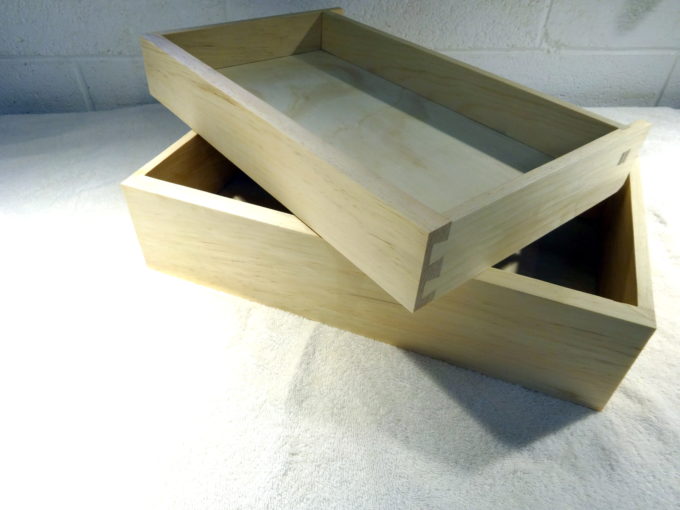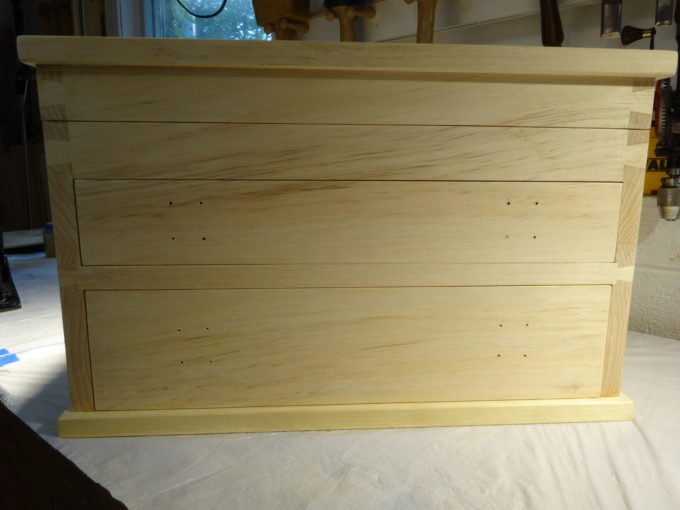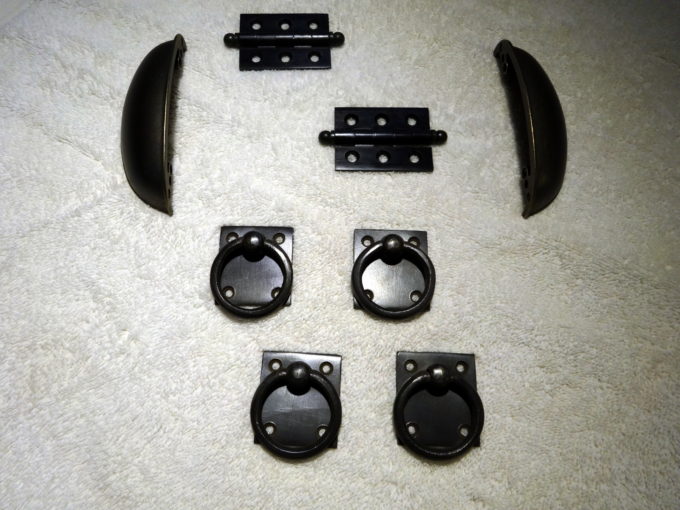 The drawers are straightforward and use common techniques. Such as, the sides joined to the fronts with half-lapped dovetails, and the floor being 1/4 inch plywood fitted into grooves. Less common is the extended length to the sides, which allows the drawer to be pulled out enough to give full access to the interior, yet have the tails keep it within the chest. Also a bit different is the back piece fitted into a housing joint and secured with wedged through tenons.
The drawers are straightforward and use common techniques. Such as, the sides joined to the fronts with half-lapped dovetails, and the floor being 1/4 inch plywood fitted into grooves. Less common is the extended length to the sides, which allows the drawer to be pulled out enough to give full access to the interior, yet have the tails keep it within the chest. Also a bit different is the back piece fitted into a housing joint and secured with wedged through tenons.
 To my eyes, “grain matching” worked out well. I cut the top front of the chest and the upper drawer front, side by side, from a section of lumber Then, I found the lower drawer front from grain running at the same angle immediately adjacent in that board. It was as much careful planning as it was happy accident to have this distinctive angular grain pattern running through that board. By the way, all lumber in this chest is some sort of mystery pine from the big orange store.
To my eyes, “grain matching” worked out well. I cut the top front of the chest and the upper drawer front, side by side, from a section of lumber Then, I found the lower drawer front from grain running at the same angle immediately adjacent in that board. It was as much careful planning as it was happy accident to have this distinctive angular grain pattern running through that board. By the way, all lumber in this chest is some sort of mystery pine from the big orange store.
 You can already see hardware mounting holes in the fronts of the drawers. The chest will end up in a place that doesn’t have room for drawer pulls that protrude very much. I chose drop ring pulls for the drawers and quickly settled on the “antique bronze” finish. That was probably a mistake, because now I was on the hunt for matching finish for the other parts. After tedious wandering through the hinterlands of the internet I gave up on finding larger, rectangular, “antique bronze” drop handles for the sides. I actually found some, but they looked like wilting lilies and their $3 per pair cost signaled they were probably junk. I compromised with some “antique bronze” bin pulls from the big orange store. The hinges come from yet another source and are yet another shade of “antique bronze.” Yet, they are very sturdy and happily the pair is actually the same size.
You can already see hardware mounting holes in the fronts of the drawers. The chest will end up in a place that doesn’t have room for drawer pulls that protrude very much. I chose drop ring pulls for the drawers and quickly settled on the “antique bronze” finish. That was probably a mistake, because now I was on the hunt for matching finish for the other parts. After tedious wandering through the hinterlands of the internet I gave up on finding larger, rectangular, “antique bronze” drop handles for the sides. I actually found some, but they looked like wilting lilies and their $3 per pair cost signaled they were probably junk. I compromised with some “antique bronze” bin pulls from the big orange store. The hinges come from yet another source and are yet another shade of “antique bronze.” Yet, they are very sturdy and happily the pair is actually the same size.
Next, a bizillion coats of shellac.
Nice work Bob! It sure doesn’t look like big orange store pine to me. Is this the Paul Seller design toolchest, or did you alter the dimensions to accommodate lathe tools?
Oops…. *Sellers
Thanks Dusty.
Yes, this is a Paul Sellers design, but to smaller dimensions. His, which you can preview here, is 30% larger in almost every dimension.
Home Depot, up here in the Northeast, has two sorts of softwood lumber, the rough construction stuff, often some sort of fir, that is usually in “2 by” dimensions, and something more like pine, slightly better “whitewood” which is in “1 by” dimensions. The lumber for the chest is from the whitewood aisle, and there is occasionally stock like this which looks to be from larger trees. I once saw the source labeled as “Radiata Pine,” plantation grown in New Zealand, but don’t know exactly if this piece was from NZ. Down where you live, you can probably easily find Southern Yellow Pine, which I would prefer.